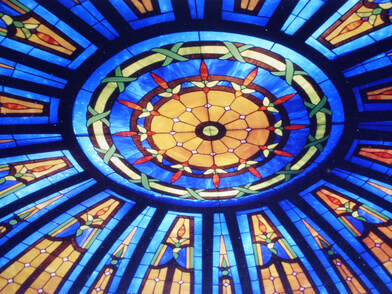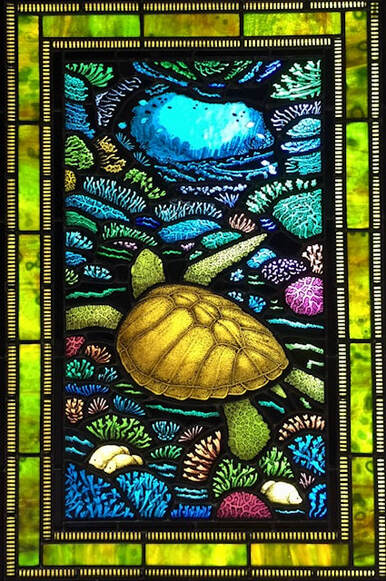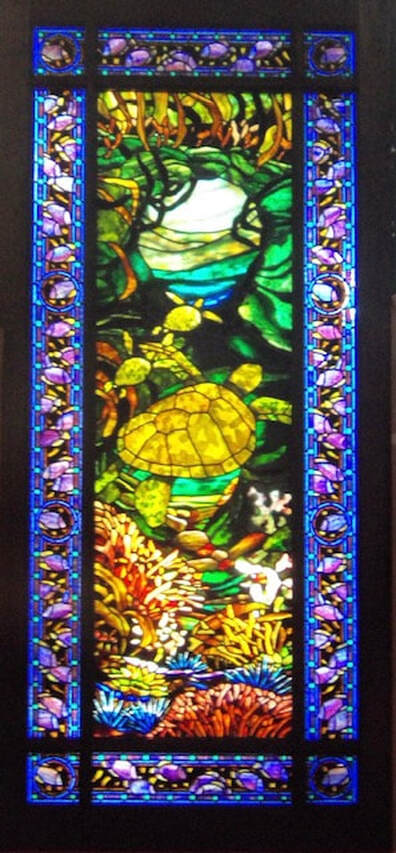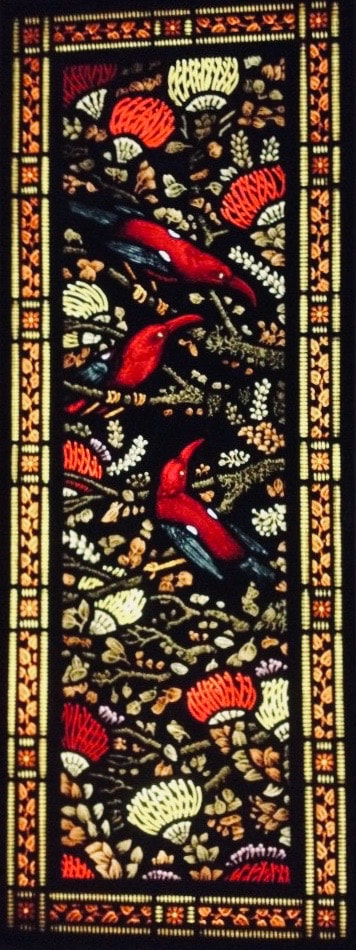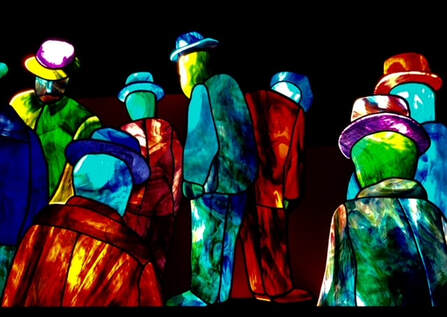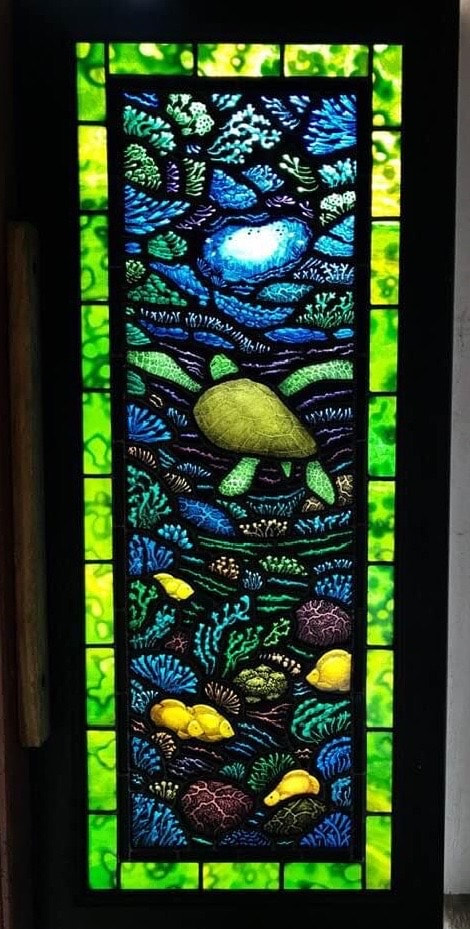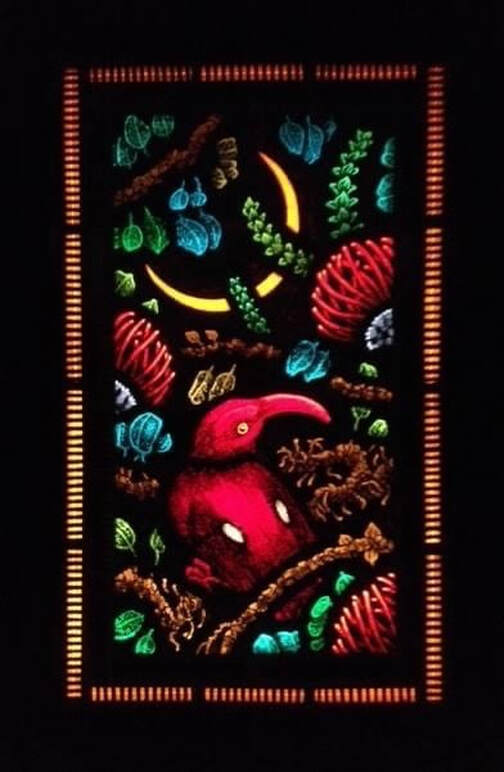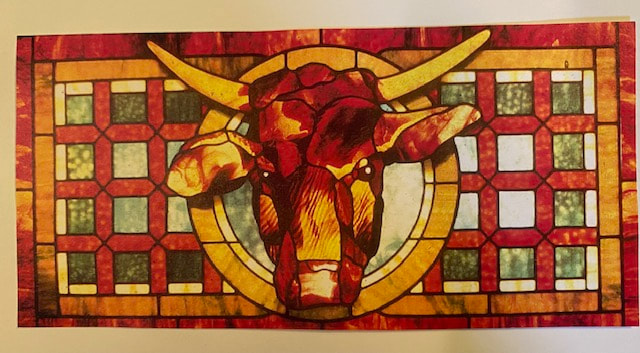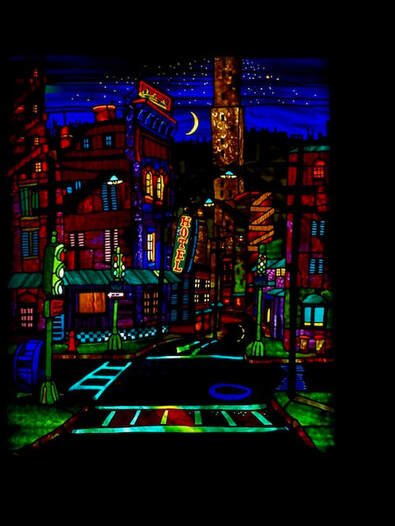Roger Moses
Stain Glass Artist
PO Box 1022
Kurtistown, HI 96760
Email: [email protected]
Telephone: 808-968-1415 Mobile: 808-937-2354
Closeup of 9’ dome, 1979, Honolulu, public commission
“Honu,” private collection, Vermont.
“Honu Cove,” 36” x 80”, private collection, Honolulu.
ARTIST’S STATEMENT
My work is driven by low light. By watching the light through the
panels, there is a softening that has been shown to be an active form of meditation.
My work is driven by low light. By watching the light through the
panels, there is a softening that has been shown to be an active form of meditation.
‘Akialoa,”
17”x 25”, private collection, Keaau, HI
17”x 25”, private collection, Keaau, HI
Hawaiian Native Birds, private collection, Wisconsin.
“I’iwi,” private collection, Oregon.
BIOGRAPHY
Roger Moses was one of the founding members of the Stained Glass. Association of Hawaii. In addition to his independent body of work, he
has also worked collaboratively and individually on many historic church restorations in Hawaii. Restoration has offered him a great
appreciation for stained and leaded glass. Having restored church windows dating from the 1880’s forward, he is still inspired by the
artistry of these installations, as well as informed of the structural challenges that come with scope and time. As a member of the Stained
Glass Association of America, he continues to study the technique of stained glass.
His work is collected privately and in public installations
globally. He is a lifelong resident of Hawaii and has resided in the Volcano area of The Big Island since 1990.
Roger Moses was one of the founding members of the Stained Glass. Association of Hawaii. In addition to his independent body of work, he
has also worked collaboratively and individually on many historic church restorations in Hawaii. Restoration has offered him a great
appreciation for stained and leaded glass. Having restored church windows dating from the 1880’s forward, he is still inspired by the
artistry of these installations, as well as informed of the structural challenges that come with scope and time. As a member of the Stained
Glass Association of America, he continues to study the technique of stained glass.
His work is collected privately and in public installations
globally. He is a lifelong resident of Hawaii and has resided in the Volcano area of The Big Island since 1990.
“Deja Moon,” 5’ x 5’, private collection, Maui, HI
“Face of Names” detail, 1982, private collection, California.
Interview with Roger Moses
TNYO: Dear Roger, during the course of exploring art and the artists who create these wonderful works of expression I have had the great opportunity to speak with you and become friends with so many wonderful people.
raised a Catholic School boy I was witness to so many religious icons and concepts within the religious
universe. Stain Glass windows were always a part of the terrain so to speak.
Coming across your work was not only inspirational but profound.
My First question is where are you from?
Roger Moses: Kansas, the upper northeast corner. Generational farmlands. I probably would still be there, had it not been for the second World War. For my father, as a returning veteran, a lot had changed. He continued his education, and we moved to the
Territory of Hawaii in March of 1954.
TNYO: Were you an Artist from a very Young age?
Roger Moses: Yes, I was very visual. It still holds true. I believe art translates creativity. Being a twin (my twin brother is 1 hour and 2 minutes older), we shared a true commonality. He is also very creative. Today we both question our early motivations. We are both very driven. On some level, my deep commitment was fueled by some form of compensation. While as a child, the creativity was born closer to the first cause: the pure joy of doing. Presently, the creativity continues to fuel energy stemming from getting lost in the process.
TNYO: Were you raised with religion ? As I was raised Catholic, I now look at religion in a much broader perspective.
I ask you this question as your work resounds with spirituality.
Roger Moses: Not in the formal sense. Through restoration work, there have been large blocks of time working alone in churches. There have been quiet conversations internally about what any of it means. This conversation continues, within any environment. Not having any answers for anyone else, while being in these churches there has never been any question as to the true purpose for my being there.
TNYOC: Can you tell us about your process when composing a stained glass window?
Roger Moses: It starts with what is certain: The actual opening, the concept, and the readily available light for the installation. Within the concept, I consider the proportions, such as the border size in relation to the field of the window. The panel evolves through the process until it is completed. Any uncertainty is resolved during the evolution of the panel.
TNYO: Is draftsmanship and drawings a part of the finished product?
Roger Moses: Drawing is a large part of it. The drawings are done in actual size. At times, an opaque projector is used. There is a 6” x 10” jar filled with 2-1/2” pencil nubs from drawings over the years. It’s full and doesn’t include pencils that “got away.” Customarily, there are 1,200 foot paper rolls, 4, 3, 2 and 1-1/2 feet in width and different weights. Some of the drawings go back 50 years. They have become reference points in more current work.
TNYO: Do you work in other mediums Roger?
Roger Moses: Stonework and woodworking, based on the early 1900’s-1930’s, cabinetry (but not furniture). The thread running through any of these mediums is having it become more refined.
TNYO: With limited knowledge of creating a final product, upon observation I have seen the framework of stained glass window in panels that are placed in what seems to be square metal framework or the large piece of glass framed as a square or rectagle in a frame. Can you explain how framing plays a part in the final piece, and how can you keep the piece safe from breaking or cracking?
Roger Moses: In larger installations, many smaller panels (customarily each under 12 square feet individually) are supported in the metal matrix, which comprise the larger stained glass window. This matrix carries the weight of the smaller panels.
As to breakage, bird, baseballs, weed eaters, etc., all pose random threats of damage. At a more earth speed detriment, acid rain, deflection from wind and the natural process of daily expansion and contraction will compromise these very ancient techniques found in the art of stained glass. Compression breaks can also occur due to the elements, i.e., flooding, earthquakes, etc.
TNYO: Another assumption I make is that the drawing of the composition comes first, then the color is applied.
Is this correct and if so how are the colors in your work applied?
Roger Moses: Some glass can direct an original idea for a panel, from the variegation of color found in a full light of glass. A panel can be inspired by the shade changes coming from the natural light through the uncut material. A cartoon can be established first, and one can stand over that cartoon and see it executed through opalescence, painted antiques, textured clears, or cathedrals. The color is in the glass, although paint can be applied. Sandblasting can be employed, as well as plating (the layering of glass from behind the panel) to control color and light.
The painted panels are painted with la Roche glass paint. Clove oil mixed with trace black is painted on colored antique glass for the initial firing, followed by additional firings utilizing vinegar and water with gum arabic for the matting and stippling over multiple fires.
On the flashed antique glass, the red flashed on clear for the birds, and the blue flashed on clear for the moon and stars was sandblasted before the paint was applied and fired.
TNYO: What is your greatest inspiration?
Roger Moses: I am inspired by glass work from the 14th century to the present day. I’m also old enough to know I’m not breaking any new ground here. I am inspired by the books and the text written on the subject of stained glass. I could be thumbing through a journal, turning page after page, and then suddenly stop at an image, and just noticing something about it. And then many years later, I might be looking through that same journal, stopping at that same page and that same image, and it would still ring true. There is some truly remarkable work in the world.
TNYO: Your work has found its way into collections across the United States. Is your work being collected overseas as well?
Roger Moses: There are pieces in five other countries, two of which belong to collectors who live in those countries.
Three are installations through commissions.
TNYO: We talked briefly about sensitivity - being an artist my whole life and being surrounded by artists my whole life
l am aware of the presence of this quality and find it within each of the artists
I work with. Do you also deal with sensitivity and do you find it valuable or maybe harmful at times?
Roger Moses: I, too, have known true artists who have expressed the active meditation that paying attention to detail requires. These people, living and dead, are in these tools, in this setting, at this bench, in this studio, at this time. Without knowing them, none of this would have been possible. This sensitivity is very valuable to my process.
TNYO: You live in Hawaii. How do you like it there and does it lend itself to creativity?
Roger Moses: It’s all there is. Coming here in March of 1954 by ship was captivating. Seeing the mololo (flying fish) flying across the dark sea as the night fell like a child from the arms of the moon, was life changing. Early on, I was taught through the culture that you could come here and be changed by it, or you could come here and change it.
Seeing the Royal Hawaiian Band from the deck of the ship playing music while wearing white uniforms with red sashes was awe-inspiring. The smell of the flowers, the wahine hula dancers, the coin divers diving for coins...all of this entered into me before leaving me ultimately changed. And that was just getting here! Now, the mountains, the marine life, the people, the food, nature, and the truth that speaks to me here are all part of my inspiration.
TNYO: Do you work in series or is each piece an individual inspiration?
Roger Moses: I have created an original piece that became a series by fulfilling the request from a client who had shown interest in a piece which was no longer available, so an additional work was done in the same venue, which would develop into the series. The painted pieces are of this genre. I do work that inspires me and that might “speak” to a client.
TNYO: You work with many commission's. Can you tell us a story about a commission you have worked on?
Roger Moses: It was a smaller commission, 17” x 60”, installed in a private residence in Pennsylvania. The piece is called “Kapoho Moon.” One of the phases for this detailed work is almost mosaic. This stage is very slow and deliberate. During this phase, we had a volcanic eruption here on The Big Island. It was extensive and reclaimed large swaths of land.
The idyllic area of Kapoho was in its path. While viewing the lava flow in lower Puna, I was influenced to include the glow of it into the piece. I included it in the section of mountains on the left side of the panel. At the offset of this commission, it was a small cottage next to a body of water. In real time, it became “Kapoho Moon” to commemorate the significance of this event, as well as the evolution of the work in the panel.
TNYO: What role does music play in your life Roger?
Roger Moses: It’s probably the one constant in my life.
TNYO: Do you listen to music when you work and if so what kind of music do you listen to?
Roger Moses: I like early blues. Presently I’m listening to Elmore James, Son House and Muddy Waters. I also like current blues, e.g., Derek Trucks and the Tedeshi Trucks Band. I love the Allmen Brothers, Cream, and Eric Clapton.
TNYO: If you were not an artist what would you be?
Roger Moses: A wood worker.
TNYO: Can you pick a song for our readers to listen to ?
Roger Moses: “Hi’ilawe,” by Gabby Pahinui.
TNYO: Dear Roger, during the course of exploring art and the artists who create these wonderful works of expression I have had the great opportunity to speak with you and become friends with so many wonderful people.
raised a Catholic School boy I was witness to so many religious icons and concepts within the religious
universe. Stain Glass windows were always a part of the terrain so to speak.
Coming across your work was not only inspirational but profound.
My First question is where are you from?
Roger Moses: Kansas, the upper northeast corner. Generational farmlands. I probably would still be there, had it not been for the second World War. For my father, as a returning veteran, a lot had changed. He continued his education, and we moved to the
Territory of Hawaii in March of 1954.
TNYO: Were you an Artist from a very Young age?
Roger Moses: Yes, I was very visual. It still holds true. I believe art translates creativity. Being a twin (my twin brother is 1 hour and 2 minutes older), we shared a true commonality. He is also very creative. Today we both question our early motivations. We are both very driven. On some level, my deep commitment was fueled by some form of compensation. While as a child, the creativity was born closer to the first cause: the pure joy of doing. Presently, the creativity continues to fuel energy stemming from getting lost in the process.
TNYO: Were you raised with religion ? As I was raised Catholic, I now look at religion in a much broader perspective.
I ask you this question as your work resounds with spirituality.
Roger Moses: Not in the formal sense. Through restoration work, there have been large blocks of time working alone in churches. There have been quiet conversations internally about what any of it means. This conversation continues, within any environment. Not having any answers for anyone else, while being in these churches there has never been any question as to the true purpose for my being there.
TNYOC: Can you tell us about your process when composing a stained glass window?
Roger Moses: It starts with what is certain: The actual opening, the concept, and the readily available light for the installation. Within the concept, I consider the proportions, such as the border size in relation to the field of the window. The panel evolves through the process until it is completed. Any uncertainty is resolved during the evolution of the panel.
TNYO: Is draftsmanship and drawings a part of the finished product?
Roger Moses: Drawing is a large part of it. The drawings are done in actual size. At times, an opaque projector is used. There is a 6” x 10” jar filled with 2-1/2” pencil nubs from drawings over the years. It’s full and doesn’t include pencils that “got away.” Customarily, there are 1,200 foot paper rolls, 4, 3, 2 and 1-1/2 feet in width and different weights. Some of the drawings go back 50 years. They have become reference points in more current work.
TNYO: Do you work in other mediums Roger?
Roger Moses: Stonework and woodworking, based on the early 1900’s-1930’s, cabinetry (but not furniture). The thread running through any of these mediums is having it become more refined.
TNYO: With limited knowledge of creating a final product, upon observation I have seen the framework of stained glass window in panels that are placed in what seems to be square metal framework or the large piece of glass framed as a square or rectagle in a frame. Can you explain how framing plays a part in the final piece, and how can you keep the piece safe from breaking or cracking?
Roger Moses: In larger installations, many smaller panels (customarily each under 12 square feet individually) are supported in the metal matrix, which comprise the larger stained glass window. This matrix carries the weight of the smaller panels.
As to breakage, bird, baseballs, weed eaters, etc., all pose random threats of damage. At a more earth speed detriment, acid rain, deflection from wind and the natural process of daily expansion and contraction will compromise these very ancient techniques found in the art of stained glass. Compression breaks can also occur due to the elements, i.e., flooding, earthquakes, etc.
TNYO: Another assumption I make is that the drawing of the composition comes first, then the color is applied.
Is this correct and if so how are the colors in your work applied?
Roger Moses: Some glass can direct an original idea for a panel, from the variegation of color found in a full light of glass. A panel can be inspired by the shade changes coming from the natural light through the uncut material. A cartoon can be established first, and one can stand over that cartoon and see it executed through opalescence, painted antiques, textured clears, or cathedrals. The color is in the glass, although paint can be applied. Sandblasting can be employed, as well as plating (the layering of glass from behind the panel) to control color and light.
The painted panels are painted with la Roche glass paint. Clove oil mixed with trace black is painted on colored antique glass for the initial firing, followed by additional firings utilizing vinegar and water with gum arabic for the matting and stippling over multiple fires.
On the flashed antique glass, the red flashed on clear for the birds, and the blue flashed on clear for the moon and stars was sandblasted before the paint was applied and fired.
TNYO: What is your greatest inspiration?
Roger Moses: I am inspired by glass work from the 14th century to the present day. I’m also old enough to know I’m not breaking any new ground here. I am inspired by the books and the text written on the subject of stained glass. I could be thumbing through a journal, turning page after page, and then suddenly stop at an image, and just noticing something about it. And then many years later, I might be looking through that same journal, stopping at that same page and that same image, and it would still ring true. There is some truly remarkable work in the world.
TNYO: Your work has found its way into collections across the United States. Is your work being collected overseas as well?
Roger Moses: There are pieces in five other countries, two of which belong to collectors who live in those countries.
Three are installations through commissions.
TNYO: We talked briefly about sensitivity - being an artist my whole life and being surrounded by artists my whole life
l am aware of the presence of this quality and find it within each of the artists
I work with. Do you also deal with sensitivity and do you find it valuable or maybe harmful at times?
Roger Moses: I, too, have known true artists who have expressed the active meditation that paying attention to detail requires. These people, living and dead, are in these tools, in this setting, at this bench, in this studio, at this time. Without knowing them, none of this would have been possible. This sensitivity is very valuable to my process.
TNYO: You live in Hawaii. How do you like it there and does it lend itself to creativity?
Roger Moses: It’s all there is. Coming here in March of 1954 by ship was captivating. Seeing the mololo (flying fish) flying across the dark sea as the night fell like a child from the arms of the moon, was life changing. Early on, I was taught through the culture that you could come here and be changed by it, or you could come here and change it.
Seeing the Royal Hawaiian Band from the deck of the ship playing music while wearing white uniforms with red sashes was awe-inspiring. The smell of the flowers, the wahine hula dancers, the coin divers diving for coins...all of this entered into me before leaving me ultimately changed. And that was just getting here! Now, the mountains, the marine life, the people, the food, nature, and the truth that speaks to me here are all part of my inspiration.
TNYO: Do you work in series or is each piece an individual inspiration?
Roger Moses: I have created an original piece that became a series by fulfilling the request from a client who had shown interest in a piece which was no longer available, so an additional work was done in the same venue, which would develop into the series. The painted pieces are of this genre. I do work that inspires me and that might “speak” to a client.
TNYO: You work with many commission's. Can you tell us a story about a commission you have worked on?
Roger Moses: It was a smaller commission, 17” x 60”, installed in a private residence in Pennsylvania. The piece is called “Kapoho Moon.” One of the phases for this detailed work is almost mosaic. This stage is very slow and deliberate. During this phase, we had a volcanic eruption here on The Big Island. It was extensive and reclaimed large swaths of land.
The idyllic area of Kapoho was in its path. While viewing the lava flow in lower Puna, I was influenced to include the glow of it into the piece. I included it in the section of mountains on the left side of the panel. At the offset of this commission, it was a small cottage next to a body of water. In real time, it became “Kapoho Moon” to commemorate the significance of this event, as well as the evolution of the work in the panel.
TNYO: What role does music play in your life Roger?
Roger Moses: It’s probably the one constant in my life.
TNYO: Do you listen to music when you work and if so what kind of music do you listen to?
Roger Moses: I like early blues. Presently I’m listening to Elmore James, Son House and Muddy Waters. I also like current blues, e.g., Derek Trucks and the Tedeshi Trucks Band. I love the Allmen Brothers, Cream, and Eric Clapton.
TNYO: If you were not an artist what would you be?
Roger Moses: A wood worker.
TNYO: Can you pick a song for our readers to listen to ?
Roger Moses: “Hi’ilawe,” by Gabby Pahinui.
“Face of Names,” 1982, 4-1/2’ x 11’, private collection, California.
“Honu Reef,” private collection, Wisconsin.
“Pueo,” 17” x “25”, private collection, Keaau, Hawaii.
“O’u,” set of two, 8” x 12” each, private collection, Connecticut.
Native Hawaiian Bird Canopy for an entry, private collection, Pennsylvania.
“Kapoho Moon,” 17” x 60”, private collection, Pennsylvania.
“Keiki I’iwi Moon,” 10” 14”, private collection, San Francisco, California.
“Second Nature,” 1979, private collection, Honolulu, Hawaii.
Orchids, 1994, 2’ x 3’, private collection, New York.
“St. Francis of Assisi,” 1988, 30” x 72”, hospital chapel installation, Ewa, Oahu, Hawaii.
“Paniolo,” restaurant commission, 1978, Honolulu, Hawaii.
"Spare Change" 1980 Private Collection In Pennsylvania
“Kailua Moon,” private collection, Oregon.

